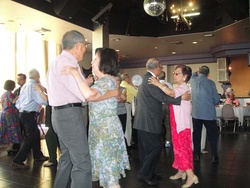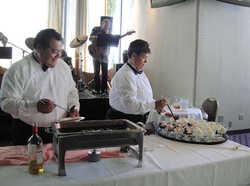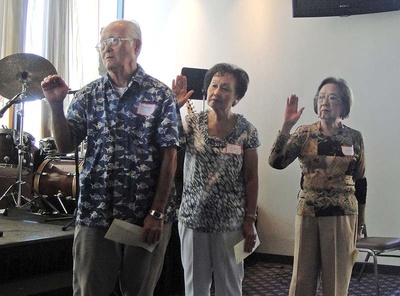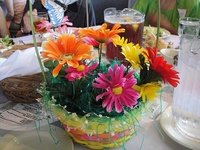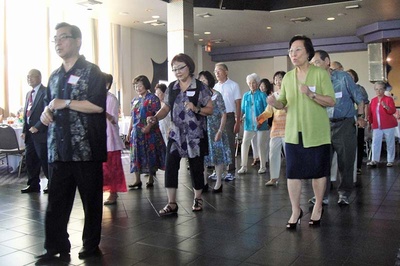Read Part 1 >>
As musical director Harry Inao cued up a recording of Dave Brubeck’s “Take Five” (“Background music provided by NWG**” as the program described it) the noise level in the room rose and our main courses of baked Atlantic salmon with hollandaise sauce and prime rib were placed before us. Itamura, who ordered the salmon, remarked, “I could use some shoyu with this, and some oroshi.”
The discussion turned to the two Obon Festivals going on that weekend. One of our tablemates told us that while Zenshuji had “better and more interesting” food, the bingo games at Nishi-Hongwanji were the best. Her solution: buy food at Zenshuji, and bring it to the big hall at Nishi-Hongwanji and eat it while playing bingo. Nishi’s bingo prizes could go as high as in the 100s, we learned, while Higashi Hongwanji’s weren’t so fat.
Before we knew it, the Dan Taguchi Group, the event’s jazz band musical act, was warming up onstage, and waiters were distributing Styrofoam boxes for leftovers. As I know from my own family experience, Nisei, more than most people, don’t like to waste food. Uiru—in a move both eco-conscious and frugal—had beaten waiters to the punch, though: she pulled out her own plastic container from home.
As saxophonist Taguchi and his Aloha shirt-clad band ran through “Take the A Train,” Kyu Sakamoto’s, “Sukiyaki” (a “foreign” song, Taguchi called it, “at least to me”), and the romantic, schmaltzy “Hawaiian Wedding Song,” NWG members began streaming onto the dance floor and twirling each other around under the disco ball.
Seated guests waited eagerly for another type of performance: the flambéing of the cherries jubilee on a long table slightly off to the side of the dance floor. My brother told me that Taguchi did a mean Louis Armstrong imitation, and sure enough, as the dessert was passed out, the bandleader adopted a gravelly, jovial voice and lit into “a requested favorite,” “Hello Dolly.” When he sang,
You’re still glowing
You’re still growing
You’re still going strong…..
anyone would have believed that the song was written for this fun-loving, swinging group. All of us Sansei agreed that we couldn’t dance half as well as our suave seniors, especially dance instructor David Shinjo, who kicked up his heels with abandon and maneuvered his partners around the floor like a Formula One race car driver tooling around in a Maserati.
Later, when I spoke to one of his impressive dance partners, Nancy Shimooka, she confessed she had never taken dance lesson in her life, and was getting light-headed from all the spinning. “I was worried I might fall and was thinking, when is this going to be over?” she confided to me.
After a 15-minute intermission, the ceremony part of the event began. The Rev. Ramos-Young recognized outgoing directors Mat Nakamura, Yoko Shimizu and Lily Yenoki, thanking them for their dedication and service. Then came the installation of the new board of directors, which looked exactly like the old board: Mat Nakamura, Yoko Shimizu and Lily Yenoki. They “graciously accepted, after a little arm-twisting,” joked the reverend, chanting, “Three more years, three more years!” The trio looked stoic, if not exactly happy.
Next came the awarding of door prizes, which is pretty standard at these events. As winners were announced, volunteer “runners” delivered prizes to winners, including a gift bag and gift certificate to Trader Joe’s, and some See’s Candies gift cards. Then the most bizarre part of the afternoon (at least to an outsider) began, as Inao drew tickets and announced the winners of cash prizes among the members and guests. “Twenty dollars for Terry Nakashima from Sumi Endo,” Inao called out, pulling tickets and announcing winner after winner. This went on for a long time.
As the cash amounts grew bigger, the crowd began “oohing” and “aaahing” more audibly. Amounts, rose to forty, then fifty dollars, finally crescendoing in a one-hundred-dollar prize. In total, members, guests and the NWG club itself, from its coffers, donated almost $900 worth of these cash prizes. It was tantamount to half the club giving a big cash bonus to the other half. Yet as my mother told me, “You have to remember that a lot of outside guests donate as well, and this is what draws people to our event!”
Next, the floral centerpiece at each table was given away to the oldest person at the table, in our case, Liz Tsuchiyama, 87, a dignified, smooth-faced woman resplendent in a lime-green suit.
Taguchi and his group retook the stage at 2:30 p.m., and as they played “Blue Bossa,” Liz’s daughter Debbie danced the swing with a dapper man in a polo shirt and khakis, Ted Shida. “New York, New York,” followed, and then a bit of slow dancing to “Misty.”
As the event drew to its end, at 3 p.m., NWG Executive Director Paul S. Saito delivered his closing remarks. Yet even then the event wasn’t really over. Dance instructor Shinjo hopped up and did a line dancing demonstration, and then the floor filled up as dozens of NWG members and guests line danced to a recording of Billy Ray Cyrus’s “Achy Breaky Heart,” then a cha-cha version of “New York, New York.”
Five hours of non-stop partying had flown by, and judging from the beaming faces (extra wattage flashing from those of big door prize winners) the event was a smashing success. As soon as one gala is over,” my mother told me, “we start planning the next one.”
© 2011 Nancy Matsumoto


